
With 35 years’ experience between them, sustainability consultants Peo and Satoko Ekberg have guided large and small organisations to ecologically greener pastures. Spreading their message of sustainability, the couple has led eco tours to Peo’s native Sweden, written four books, delivered countless lectures, and held workshops around Japan and worldwide.
Yet they found themselves looking for something more. The decision to purchase their own home offered the opportunity to implement the mantra they have shared with numerous others: “don’t take more than you can give back; only take from above the ground”.
Partly motivated by the World Wildlife Fund’s (WWF) Living Planet Report 2010 revelation—at the current rate of consumption, the human race will require two planets by 2030—the Ekbergs wanted to create a comfortable home only needing the support of one planet.
“Right now we’re using 1.5 planets. If we don’t change by 2030, we’ll need a new planet. We need to reduce [our consumption] by one half or double our efficiency. Satoko and I decided we wanted to have a ‘One Planet’ apartment. At the same time, we didn’t want to lose comfort”, he said.
“Living sustainably does not mean suffering”, he added.
The Ekbergs sourced each item, fixture and material to create a home that reflects their ideals and personalities. Knowing where something comes from and how it is made is essential to their definition of sustainability, making it possible to make informed decisions.
They chose renewable and recycled materials, from wooden floors and double-paned windows that allow candles to help heat their home, to a bathroom with naturally mould-resistant walls. Carefully researched, everything was sourced from above ground and certified by the Forest Stewardship Council (FSC), the non-profit organisation promoting responsible management of the world’s forests.
“We did nearly 100 sustainable things, but they weren’t randomly chosen. I have been working in this field for 25 years, but it was a lot of words. It was time to put those words into real shape”, said Peo.
Six months after moving in, even the Ekbergs were surprised at how well they had succeeded. Using the Water, Energy, Health, Agriculture and Biodiversity (WEHAB) framework from the 2002 United Nations Sustainable Development Summit in Johannesburg, South Africa, they compared their actual usage with 2008 figures obtained from Japan’s Ministry of the Environment.
“The first six months were amazing. From August to March, we reduced our water usage by 68%, our energy (gas and electricity) by 45%, health (garbage) by 82%, and agricultural and biodiversity damage (CO2 emissions) by 88%”, said Peo.
“We’re just doing it—walking the talk; proving it is possible to live sustainably and comfortably”, said Peo.
Please e-mail info@ecotwaza.com quoting BCCJ ACUMEN for all information and orders, and to receive bonus points.

Keiso-Kun Grade Wall Finish: made of soil comprising fossilised remains of microscopic algae.


